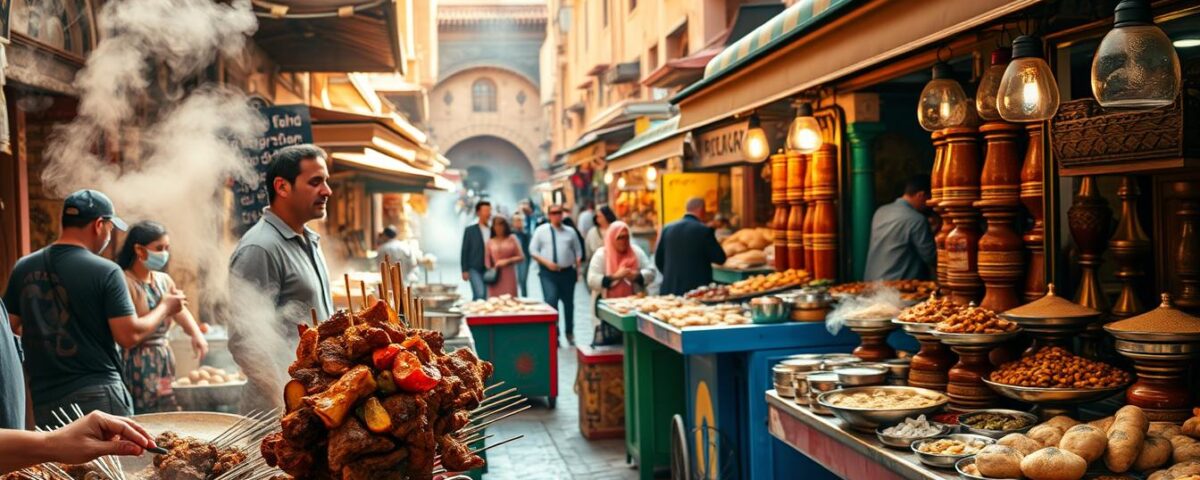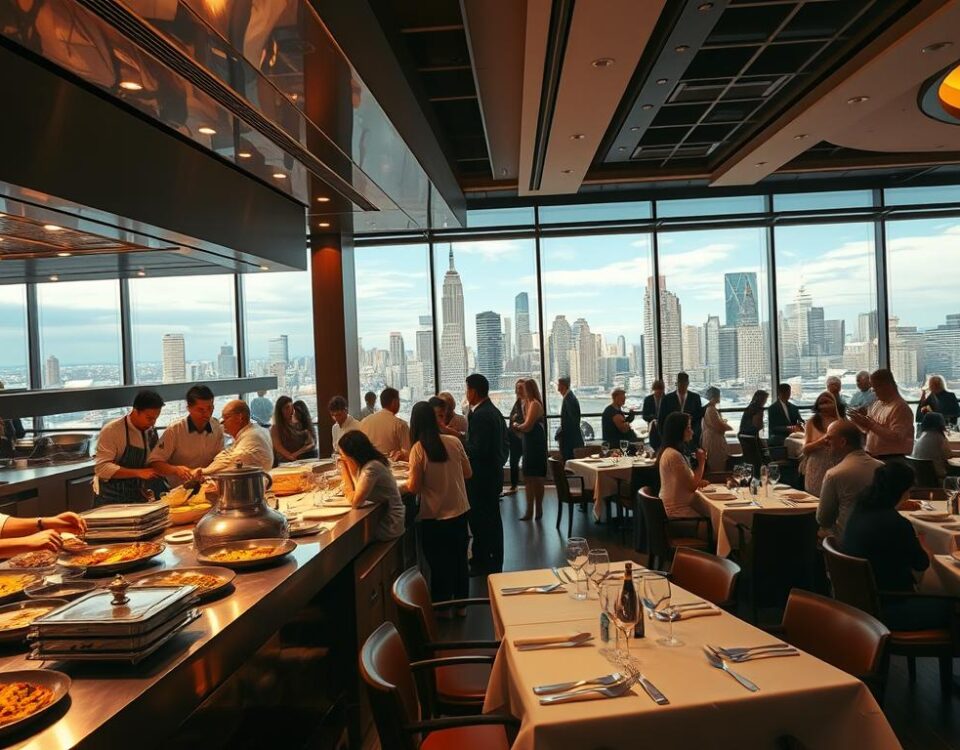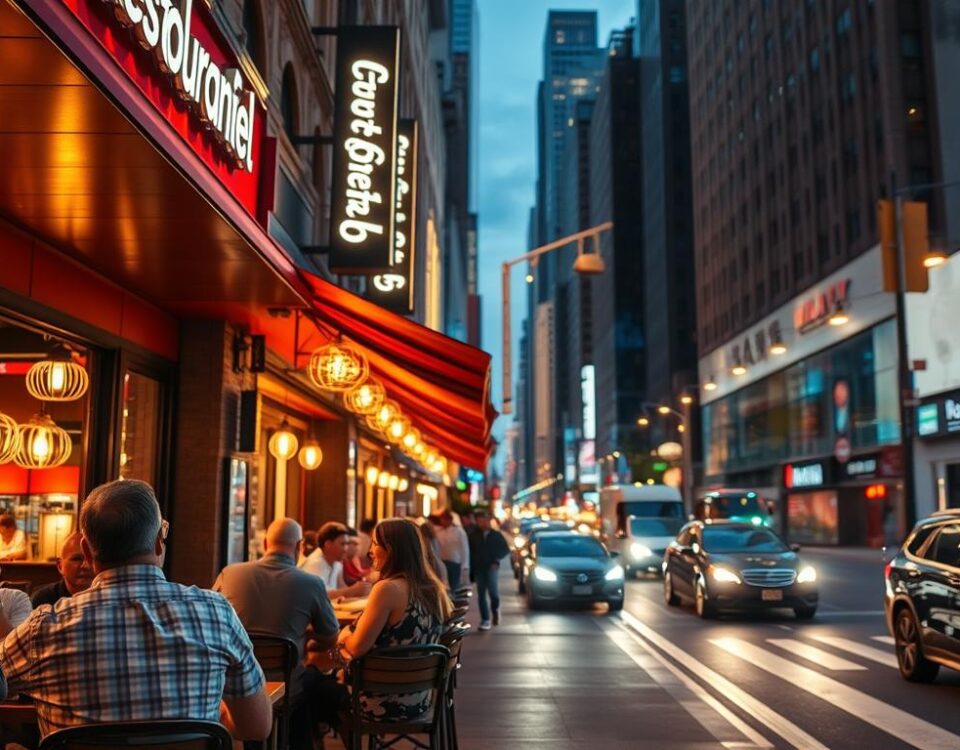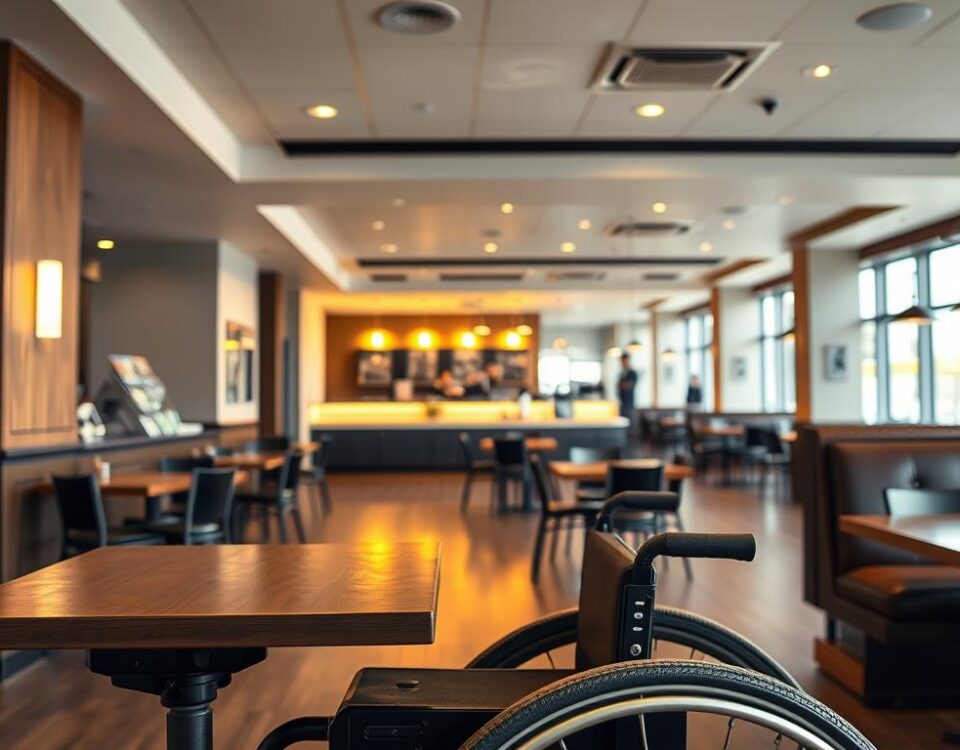
Where to Go for Late-Night Eats in Las Vegas
June 8, 2025
Top Places to Try Traditional Food in Amsterdam
June 9, 2025Did you know Marrakech’s main square buzzes with over 100 food stalls by sunset? My first visit left me speechless—not just from the heat, but from the whirlwind of sizzling pans, fragrant spices, and laughter echoing through narrow alleys. I’ll never forget biting into a flaky msemen pancake drizzled with honey while a vendor joked, “Careful, it’s sweeter than a Moroccan wedding!”
This city taught me that eating here isn’t just about meals—it’s a dance of flavors. One morning, I stumbled upon a tucked-away stall serving harira soup, its tomato broth simmering with lentils and tender beef. Locals squeezed onto wooden benches, slurping alongside tourists clutching maps. That’s the magic: every corner offers something unexpected, from olive oil-drenched breads at breakfast to sugar-dusted pastries at midnight.
What surprised me most? How modern twists blend with tradition. I found a cozy spot mixing mint tea with avocado smoothies, proof that even centuries-old cuisine evolves. But the heart remains unchanged: smoky grills, hand-rolled couscous, and stalls in Jemaa el-Fnaa Square serving freshly squeezed orange juice until dawn.
Key Takeaways
- Marrakech’s culinary scene thrives on energy and spontaneity, with options available at all hours.
- Traditional ingredients like olive oil, tomatoes, and mint tea define the local flavor profile.
- Street stalls offer both quick snacks and hearty meals, blending authenticity with modern influences.
- Popular spots like Jemaa el-Fnaa Square require attention to food safety and vendor reputation.
- Exploring beyond tourist areas reveals hidden gems loved by locals.
Introduction: My Marrakech Culinary Adventure
Navigating the medina’s labyrinth felt like stepping into a spice-scented storybook. My sandals scraped against ancient stones as smoke from grilling lamb curled around orange crates stacked high. A vendor waved me over, his hands cradling warm msemen like edible treasure maps. “Eat here once,” he grinned, “and you’ll dream in cumin.”
Where Locals and Flavors Collide
Jemaa el-Fna’s energy hit me like a tidal wave. Drumbeats dueled with sizzling pans as families shared tagines beside tourists snapping photos. I learned quickly: the busiest stalls often hide the best cuisine. One cook stirred beans in a copper pot older than my passport, while another pressed mint leaves into glasses of tea with ceremonial care.
Tasting Trust, One Bite at a Time
My friend Amina, born in the medina, taught me to spot quality. “See the oil?” She pointed to a shimmering skillet. “Fresh olive oil never lies.” We dodged tourist traps serving bland couscous, finding instead a tucked-away counter where spiced beef melted over chickpeas. That meal—washed down with apricot juice—changed how I view quick snack stops forever.
| Experience | Tourist Spot | Local Favorite |
|---|---|---|
| Cost | $8-15 per meal | $2-5 per dish |
| Wait Time | 15+ minutes | Immediate seating |
| Ingredients | Pre-chopped veggies | Hand-ground spices |
By dusk, I understood the city’s rhythm. Meals here aren’t just eaten—they’re lived. From sunrise fruit carts to midnight chicken skewers, every bite whispers secrets older than the Atlas Mountains.
Exploring Marrakech Street Food Snacks
The sizzle of a skillet stops you mid-step. Golden pastry layers puff up like edible origami while a vendor flips lamb kebabs over glowing coals. This isn’t just eating—it’s theater where every dish tells a story.
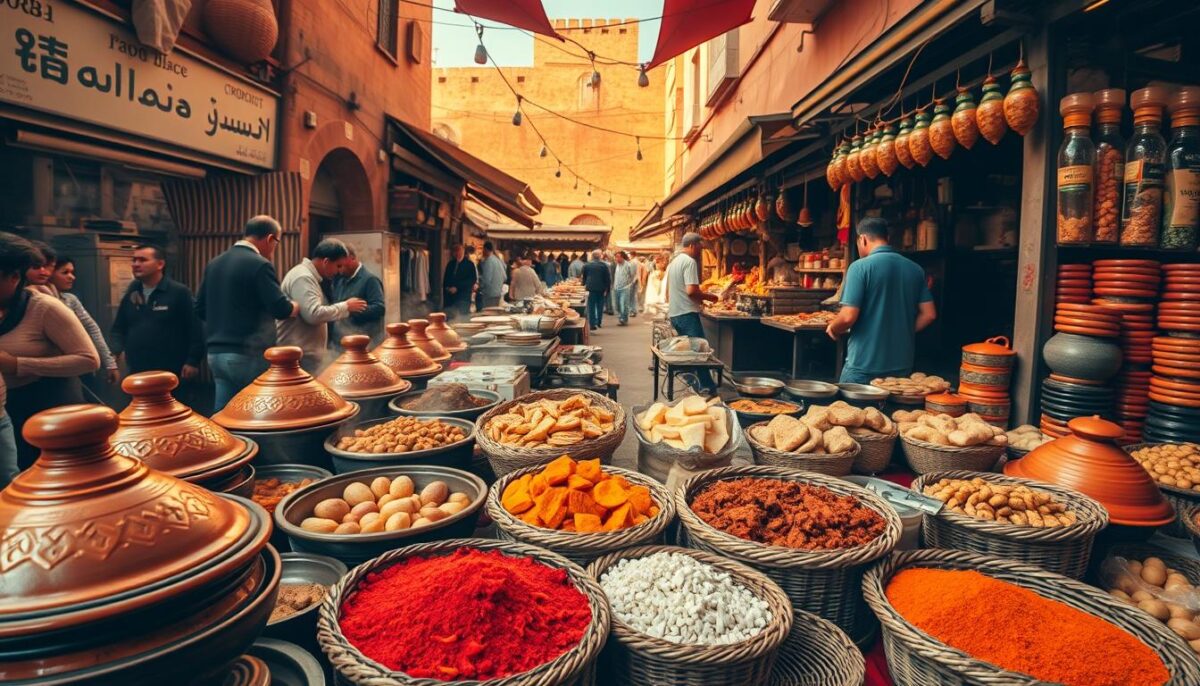
What Makes These Bites Uniquely Moroccan
Freshness rules here. I learned to spot stalls with bubbling oil that smells clean, not burnt—a sign they’re frying fish or chicken to order. One cook showed me his pot of simmering tomatoes: “We chop these at sunrise,” he said, stirring a ruby-red sauce for egg-topped khlea.
Texture contrasts surprise you. Crunchy sugar-dusted cookies give way to feather-light semolina layers. At a bustling corner, I bit into a flaky briouat stuffed with spiced meat—its crisp shell shattered like caramelized glass.
Meat becomes art. Vendors marinate lamb for hours in garlic and paprika before grilling. Pair it with mint tea so strong it makes your cheeks tingle—that’s how locals test a stall’s authenticity.
Want the full experience? Follow the steam. A cloud rising from a tiny cart often leads to pastry masters folding dough into rose shapes or fish sizzling in clay pans. These aren’t snacks—they’re edible postcards from Morocco’s soul.
Breakfast & Brunch Delights
Dawn in the medina smells like butter-toasted semolina and orange blossom water. My mornings begin with steaming glasses of mint tea poured from silver pots, served alongside honey-drenched baghrir pancakes. At Café 16, a sunlit terrace spot, I discovered their seasonal breakfast tagine—eggs baked with tomatoes and local herbs in a clay pot.
Classic Morning Meals and Patisserie Favorites
Nothing beats Snack Othman’s beldi breakfast: crusty bread dipped in golden olive oil, paired with fig jam and soft goat cheese. For pastry lovers, the almond-filled kaab el ghzal at Dar Cherifa melts like edible silk. Pro tip: arrive early—the best food stalls sell out by 9 AM.
Beyond the Tourist Trails
I stumbled upon a rooftop gem near Ben Youssef Madrasa where locals share communal platters of couscous with raisins and caramelized onions. Another find? A tucked-away courtyard serving avocado-topped msemen flatbreads—a modern twist that’ll make you rethink brunch forever.
| Spot Type | Must-Try Dish | Best For |
|---|---|---|
| Classic Cafés | Harcha (semolina bread) | Traditionalists |
| Modern Eateries | Avocado mint smoothies | Adventurous palates |
| Hidden Medina Spots | Saffron-infused porridge | Unique experiences |
Whether you’re sipping tea in a centuries-old riad or biting into sugar-dusted pastries at a family-run counter, mornings here taste like possibility. As one vendor told me while handing me a warm msemen, “Breakfast isn’t a meal—it’s our first love story of the day.”
Midday Meals and Quick Bites on the Medina
When the sun climbs high over the clay rooftops, the Medina transforms into a symphony of clattering pans and sizzling meat. I learned to follow my nose—woodsmoke curling from tangia pots blends with the zing of fresh lemon squeezed over chicken skewers. One vendor laughed as he handed me a steaming wrap: “Lunch here moves at the speed of life!”
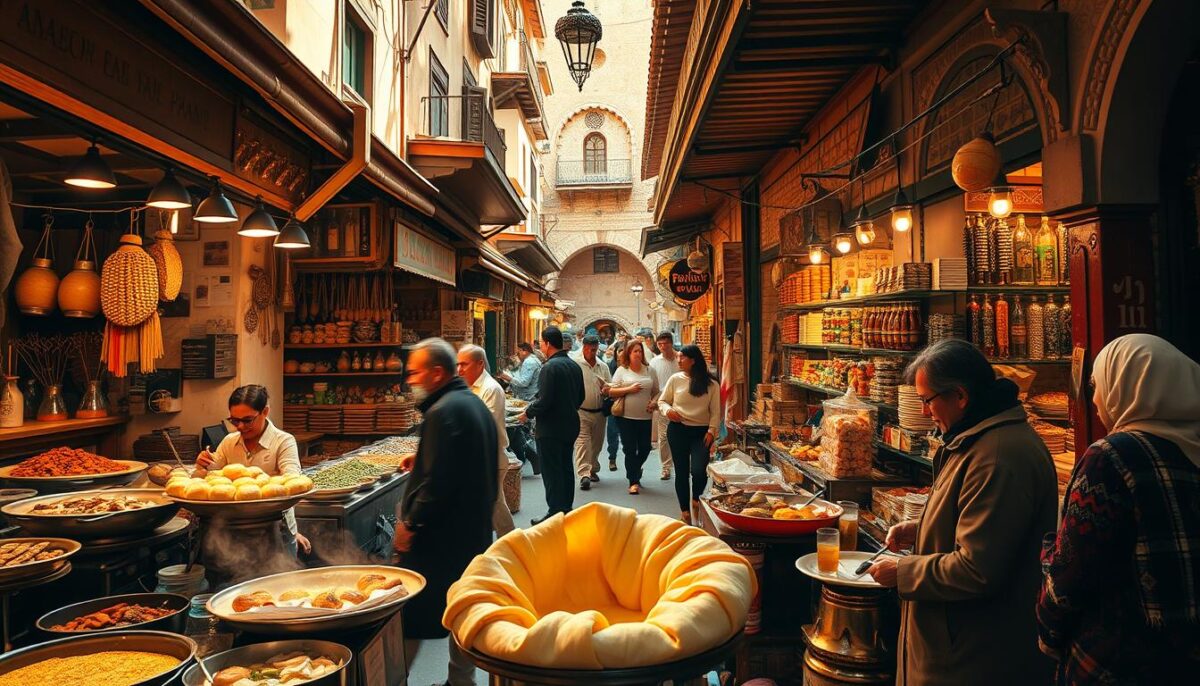
Golden bread baskets line countertops, ready to scoop up slow-cooked soup or spiced couscous. At a cramped stall near the tanneries, I watched cooks layer tender lamb with preserved lemons in earthenware tagine pots. Their secret? Spices ground that morning with mortar and pestle.
| Dish | Preparation Time | Best For |
|---|---|---|
| Tangia | 4+ hours | Rich, meaty flavors |
| Lamb Kebabs | 15 minutes | Quick protein boost |
| Harira Soup | 2 hours | Comfort food seekers |
Locals taught me to spot quality: look for stalls where workers refill water pitchers often—a sign of high turnover. The best spots? Follow office workers clutching paper-wrapped snack bundles back to their shops.
Midday meals here weave through the city like a dance. Vendors banter with regulars while spooning saffron rice onto plates. As one cook told me, wiping his brow near a bubbling pot: “We make fast food, but never fast flavor.” Every bite proves him right.
Hidden Gems and Must-Try Street Vendors
A blue door in a quiet alley swung open, revealing steam rising from a copper pot older than my grandmother’s recipes. This wasn’t a restaurant—just a family cooking lamb tagine in their renovated riad courtyard. “We only make twelve dishes daily,” the cook explained, handing me bread to scoop up tender meat simmered with spices.
I learned to spot hidden treasures by watching locals. Office workers in pressed shirts led me to a corner stall serving harira soup so rich it could warm a winter night. Students clustered around a cart flipping pastry triangles filled with lemon-chicken—each bite crispier than Atlas Mountain air.
| Feature | Common Spots | Hidden Gems |
|---|---|---|
| Crowds | Tour groups | Neighbors chatting |
| Utensils | Plastic plates | Hand-painted ceramics |
| Smells | Generic spices | Toasted cumin seeds |
Behind Jemaa el-Fna’s chaos lies a square where elderly men sip mint tea beside paper-wrapped snack bundles. One vendor here taught me his trick: “Good meat needs three things—time, fire, and silence.” His clay pot of slow-cooked beef proved it.
Trust these signs: oil changed daily, water pitchers refilled hourly, and cooks who smile while stirring. The city’s true flavors live where tourists rarely wander—in shared courtyards and alleys smelling of charcoal and trust.
Tips for Safe and Delicious Street Food Experiences
I learned the hard way that not all sizzling pans promise flavor—some hide shortcuts. One afternoon near Jemaa Fna, I watched a cook refry beans in oil darker than molasses. My stomach protested for hours. Now, I follow these rules to savor every bite worry-free.
Hygiene and safety pointers from my travels
Trust your eyes first. Clear oil means fresh frying—if it’s cloudy, walk away. I always check how vendors handle ingredients. Are tomatoes washed? Does mint tea come from sealed containers? These details matter.
Follow the locals. A stall packed with workers grabbing soup at lunch? That’s your spot. I once joined a line of nurses near Jemaa Fna—their tagine lunch proved unforgettable. Crowds mean turnover, which means fresher dishes.
| Do | Don’t |
|---|---|
| Drink bottled water | Accept ice from unknown sources |
| Choose busy food stalls | Eat pre-cut fruits |
| Watch olive oil freshness | Ignore handwashing habits |
Stick to cooked classics. Simmering beans or steaming harira are safer bets than raw salads. A vendor once told me, “Heat kills mistakes”—words I live by. Book tours with guides who know hidden places; they’ll steer you right.
Your nose knows. If a city corner smells like yesterday’s grease, keep moving. But when charcoal smoke mingles with cumin? That’s where magic happens. Trust that instinct—it’s saved me countless times.
Conclusion
My journey through the city’s alleys taught me that every meal is a passport to Morocco’s soul. From sunrise food carts to midnight grills, I discovered flavors hiding in unmarked places—a butcher-shop-turned-soup-kitchen here, a grandmother’s spice blend there.
Three lessons stayed with me: trust sizzling skillets with queues of locals, always choose bottled water, and let curiosity guide you. That hole-in-the-wall serving lamb-stuffed dates? Worth every dirham.
Each vendor shared more than street food—they offered stories etched in saffron and preserved lemons. I’ll never forget the cook who whispered, “Our recipes remember what our hands forget,” while folding dough into golden triangles.
To taste this city is to embrace its contradictions. Modern juice bars sparkle beside century-old tea stalls. Hidden places surprise you with avocado-stuffed breads while honoring ancestral spice mixes. Ready your appetite—Morocco’s culinary heartbeat waits where the aroma of cumin meets courage.
FAQ
What’s the best way to find authentic morning meals in the medina?
I always follow the locals! Head to smaller alleys near Jemaa el-Fna for flaky msemen (griddled pancakes) or baghrir (spongy semolina crepes) drizzled with honey. Look for spots where families gather—they know where the freshest olive oil and sweet mint tea flow.
How do I avoid getting overwhelmed by the food stalls?
Start with a guided tour—it helped me focus on iconic bites like tangia (slow-cooked lamb) or harira soup. Vendors often let you sample spices or dried fruit first. Trust your nose: if a stall smells like cumin and smoked paprika, you’re in for a treat!
Are there vegetarian-friendly options available?
Absolutely! I fell in love with zaalouk (eggplant dip) and chickpea-based dishes. Many vendors use seasonal produce like tomatoes and beans. Just ask for “khobz” (bread) without meat—it’s common to customize tagines or couscous with extra veggies.
What’s your top tip for staying safe while eating from vendors?
Watch how they handle ingredients. I stick to stalls that cook meat fresh (like grilled kefta) or fry items like briouats (stuffed pastry) in hot oil. Avoid tap water—opt for bottled drinks or steaming hot tea poured from a shiny pot.
Can I try street food if I’m on a tight schedule?
Definitely! Grab quick bites like maakouda (potato fritters) or skewered beef from carts near the main square. Many vendors wrap snacks in paper—perfect for munching while exploring the souks. Pro tip: sunset is prime time for affordable, flavorful feasts.
How do I know if a hidden gem is worth the hunt?
Look for lines of locals—it’s how I discovered a tiny stall serving melt-in-your-mouth lamb tagine. Don’t shy away from spots with plastic stools; some of my best meals (like harira with dates) came from unassuming corners. Bring small bills—it’s easier to bargain for extras like olives or preserved lemons.
